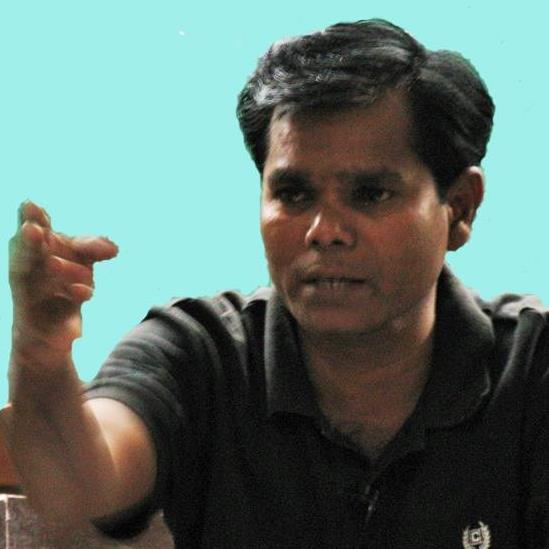Ratnesh Katulkar
 The Rajputs from medieval times (which is the actual period of their appearance in Indian soil) portray their patriarchal male valor and military dominance through various folklore. In the recent Padmavati protest, the Karni Sena- the new outfit of Rajputs once again showed their bravery by attacking a bus carrying school going kids.
The Rajputs from medieval times (which is the actual period of their appearance in Indian soil) portray their patriarchal male valor and military dominance through various folklore. In the recent Padmavati protest, the Karni Sena- the new outfit of Rajputs once again showed their bravery by attacking a bus carrying school going kids.
In the recent past, the Rajputs also supported the Ranvir Sena, a feudal army of Bhumihars; and had shown their dominance against the landless Dalits in the form of mass killings in various parts of the country, particularly at Laxmanpur Bathe, Shankarbigha, Narayanpur, and Bathani Tola of Bihar. One cannot forget the infamous Behmai incidence where a group of Rajputs committed a brutal mass rape. Apart from these inhuman acts, the dominance of Rajputs on their own women is well known. The Rajputs played a prominent role in encouraging many evil customs such as the Parda system, Sati system, female infanticide and enforced widowhood in India.
Yet, despite their dominance over Dalits, women, and children, it is a known fact that the Rajputs proved to be very weak and meek before foreign invaders.
Late Professor Tulsi Ram in his a lecture at JNU on October 17, 2013, said that there are so many myths created to show the valor of Rajputs, with their royal poets portraying them as very strong, as the most powerful beings in the universe, yet it is strange that all the foreign invaders attacked India from Rajasthan only! These powerful Rajputs were not able to stop even a single invader. It is a fact that none of the Rajputs were able to resist a single Turk, Afghan or Mongol invader.
The Rajput valor is just a propaganda and a myth. Their folk propagandists even tried to seek Rajput bravery in their loss in battles by narrating various excuses. And interestingly, the mass suicide of Rajput women in the form of the mythic Padmavati episode has also been celebrated as an example of Rajput valor.
It is true that the Rajput women were always under the pressure of Rajput patriarchy but there are two historical pieces of evidence when Rajput queens openly revolted against patriarchy. One is the well-known case of Mira Bai who revolted against her husband to become a disciple of the Dalit saint Ravidas. This is of course not only a revolt against patriarchy but also against the caste system.

Mira
The second is the case of a queen who revolted against her Rajput husband. Interestingly, this incidence is related to Ala-ud-din Khilji, who was portrayed as a villain in Bhansali’s film Padmaavat.
The textbooks on medieval India say that there was a Rajput King Karan Deva II ruling in Gujarat, his wife was Kamala Devi. In the year 1299, Ala-ud-din sent Ulugh Khan and Nusrat Khan to conquer Gujarat. The Delhi armies besieged Anhilwara and captured it. Kamla Devi, the beautiful queen of Karan Deva fell into the hands of the army. On this matter, well-known historian Satish Chandra, says that Ala-ud-din was actually invited to invade this kingdom by the Chief Minister of King Karan for the reason that he had forcefully seized his wife in his absence, and had done many other illegal acts. This battle was easily won by the Turks, who took all treasures, and the beautiful chief queen, Kamla Devi. The queen was treated with respect. Later Allauddin Khilji married this Rajput queen Kamala Devi. Historians say that she soon won the Sultan’s affection with her beauty and devotion and became his favorite, among all his wives. Kamala Devi’s influence was so strong on Allauddin that she planned many political and social ambitions for him.

A page from Amir Khusrau’s Ishqiya
On the one hand, she had gained the full affection of Allauddin, and on the other, she was engaged in another battle with her ex-husband Raja Karan. She requested Allauddin to attack him and bring her daughter Deval Devi, who was with her first husband. Accordingly, in March 1307, Allauddin sent an expedition against Ram Chandra Dev who gave refuge to Raja Karan. Again, as usual, the Rajputs were not able to defend their kingdom; and Deval Devi, (Kamala Devi’s daughter) was brought to the kingdom of Allauddin. Later she was married to his son Khizr Khan. This was not a forced marriage as both of them fell in love with each other. Similar to Malik Muhammad Jayasi’s Padmavat, Amir Khusrau wrote a love story titled “Ishqiya”. Unlike the fictional Padmavat, this was a real love story between a Rajput princess and a Khilji prince.
But these Rajputanis’ revolt against patriarchy and casteism are totally ignored by the Rajputs for whom only Jauhar (mass Sati) of Rajput women is an act of heroism.
~~~
Ratnesh Katulkar works at Indian Social Institute, New Delhi. Ratnesh Katulkar’s upcoming (unpublished) booklet ‘Dr Ambedkar Aur Adivasi Prashn?‘ counters the arguments of ‘progressives’ who are charging Dr Ambedkar with working against Tribal rights. He can be contacted at: ratnesh.katulkar@gmail.com
Images courtesy: the internet









